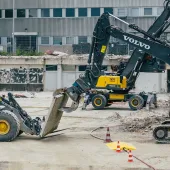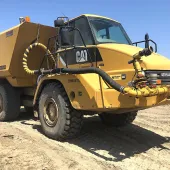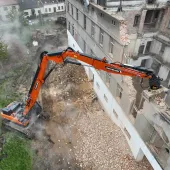BossTek launch new DB-10 dust-suppression system
Latest DustBoss model provides effective indoor dust control in demolition applications
BOSSTEK, specialists in mobile dust-suppression equipment, have launched a new addition to their line of atomized mist cannons with the introduction of the new DustBoss DB-10. Specially engineered for enclosed working environments, the easily manoeuvrable air cannon provides effective suppression of dust in a compact, portable design.
Suitable for applications such as demolition and materials handling, the air cannon provides airborne particle control with fewer particulate emissions, less standing water, and a safer, more compliant workplace.
‘Our customers are well-acquainted with our technology, but before the DB-10, the smallest machine could nearly cover a football field, which is far too powerful for most indoor applications,’ said Mike Lewis, dust control specialist at BossTek.
‘Our first customer to use the DB-10 was a demolition contractor removing dusty drywall, plaster and tile containing potentially hazardous materials. These all produce highly regulated dust emissions. We worked with them to create a unit best suited to their needs and the DB-10 was born. They are extremely happy with the outcome.’
Mounted on two wheels with a tall handle, the compact mist cannon is light and easy to manoeuvre, whilst still offering industrial-level dust control. Powered by a 120V current, the DustBoss DB-10 fan generates 3,335 cubic feet per minute of airflow.
Water is delivered through a circular manifold (mounted at the front of the cannon) with 12 atomizing nozzles, providing a 30ft (10m) range. The DB-10 unit also features 0-50º vertical adjustment, allowing the mist to reach into the rafters of warehouses, or be directed at specific emission zones.
Beyond space constraints, the DustBoss dust-suppression system solves several issues associated with dusty indoor operations. During indoor demolition, for example, harmful dust can fill the area and drift across the site line, creating a violation, but atomized droplets stop dust at the point of emission. Workers are often assigned to use hoses for small-scale dust suppression, which adds to the labour cost, whereas the DB-10 unit requires no manual labour.
Moreover, being in proximity of large machinery and falling material can be hazardous to personnel. To help prevent dust, the DB-10 produces droplet sizes between 50 and 95μm – roughly the same as the cross-section of a single human hair. This is important because regulators test for respirable dust 10μm or less, such as those found in indoor demolition.
The slipstream created by droplets greater than 200μm in size can deflect tiny respirable dust particles, rather than absorbing them. This, say BossTek, means hoses are generally not effective against airborne dust.
Using less than a quarter of the water volume of a handheld 1in hose, the DB-10 fog cannon fills the area with a dust-trapping mist that stops particulates from remaining airborne or migrating away from the area. The wide area of distribution and gentle settling reduces the chance of pooling and runoff.
A demolition contractor was recently performing indoor demolition and found that disruption to storage piles of recycled material was causing airborne dust emissions. Although piles could be covered at night, activity during the day was causing particles to drift into neighbouring communities.
BossTek were approached and an on-site demonstration of their DB-10 system showed the contractor that the atomized mist pulled the dust out of the air at the point of emission, preventing it from traveling across the site line. The fog cannon effectively controlled both airborne and ground-level particles with no runoff or puddling.










